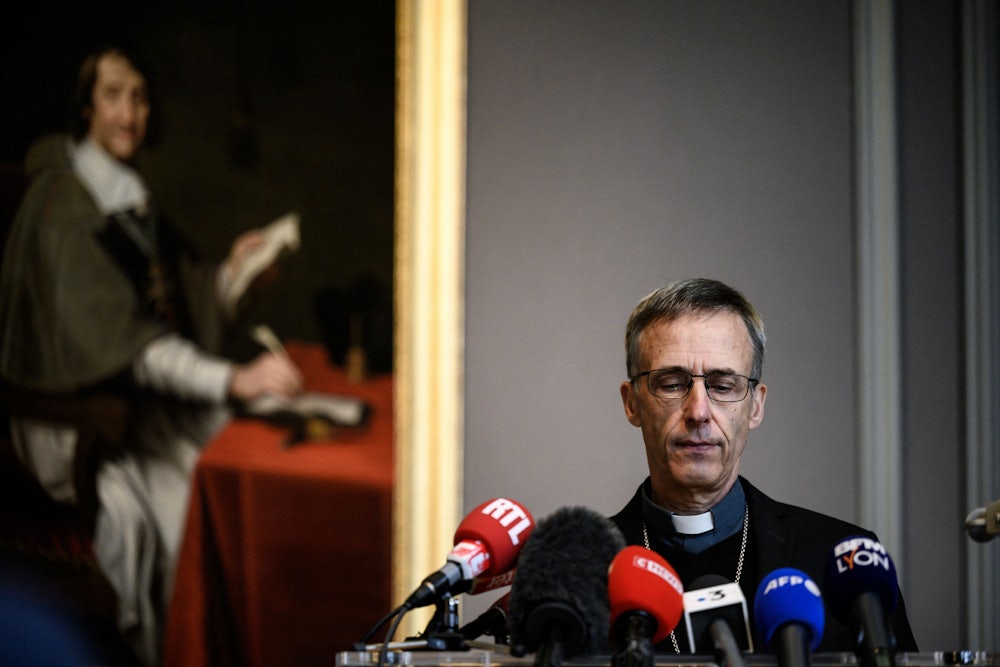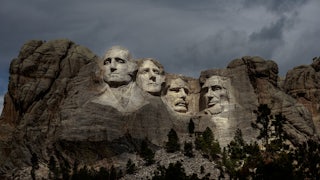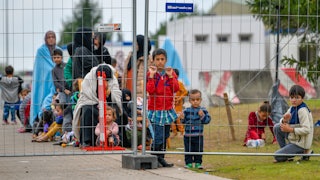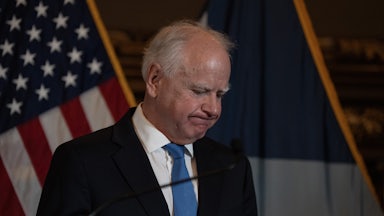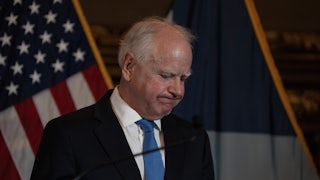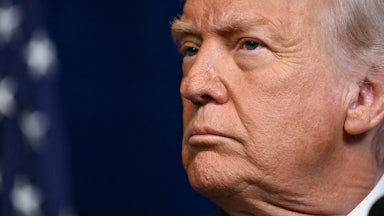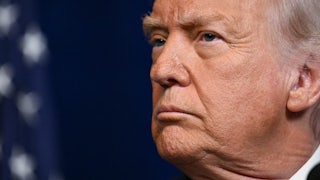In a report earlier this week, a French commission on child sexual abuse in the Catholic Church found that more than 330,000 children had been abused over the past 70 years, with about two-thirds of them abused by Catholic clergy. The revelation is the latest and perhaps most exhaustive look yet into a phenomenon found around the world—and it’s a stark reminder of how the United States, after all these years, still hasn’t produced a full accounting of its own such tragedy.
Nearly two decades ago, the U.S. was the epicenter of the crisis after The Boston Globe uncovered widespread abuse and systemic cover-ups in local parishes. The Catholic abuse scandal now occupies that strange space between history and current events, neither immediate nor distant in public memory. With law enforcement avenues apparently exhausted, a national inquiry may be the best chance for accountability.
The French commission’s efforts were comprehensive: According to The New York Times, the 21-member panel of experts conducted more than 250 hearings and heard testimony in some form from almost 6,500 people, producing a report that totaled more than 2,500 pages. The closest the U.S. came to such an inquiry was a 2004 report by the John Jay College of Criminal Justice. Researchers sent surveys to almost every Catholic diocese and organization in the U.S. and asked a wide assortment of questions about sexual abuse by clergy or other officials. Based on the responses, the investigators found that nearly 11,000 people had made allegations of child sexual abuse against Catholic priests between 1950 and 2002. They also found 4,392 priests with allegations of abuse made against them, totaling roughly 4 percent of the entire priesthood during that time period. The 2004 report’s numbers are often cited in reporting on the overall situation in American parishes.
There are good reasons to believe that these numbers are undercounts, especially the number of survivors. Some of those reasons are methodological. For one, the college relied on self-reported information from the church itself, which would exclude people who chose not to report their abuse at all. Social stigma is a well-known hurdle when studying sexual abuse of any kind. The report also does not include allegations made to law enforcement or other institutions. Unlike the French inquiry or other similar efforts overseas, researchers did not seek out or invite survivors to report allegations to them directly.
The John Jay College report, though comprehensive and groundbreaking, had other shortcomings. Perhaps most conspicuously, the report was initiated and funded by the U.S. Catholic bishops’ conference. Other prominent inquiries have maintained a greater degree of independence from church authorities and drawn from sources beyond those possessed by the church to determine the extent of the problem. A follow-up report released in 2011 also received criticism from survivors’ groups and advocates amid questions about the reliability of its data and the limits of its scope.
More recent and more focused U.S. inquiries have turned up numbers of allegations that call into question the 2004 figures. From 2016 to 2018, a Pennsylvania grand jury closely examined more than 500,000 internal church records from six of the state’s eight Catholic dioceses and heard testimony from dozens of survivors. Its final report, which totaled more than 800 pages, found more than 1,000 individual survivors since the 1950s. That would be nearly 10 percent of the total number estimated by the John Jay College report, and yet Pennsylvania Catholics account for just 5 percent of American Catholics in total.
National inquiries conducted in other countries also point to far higher figures. A royal commission in Australia, which spent four years, reported in 2017 that it had found more than 4,400 survivors of abuse by Catholic priests and clergy since the 1980s. Despite the narrower window of time and Australia’s substantially smaller population—roughly 25 million people compared to roughly 335 million Americans—the commission’s total amounts to more than one-third of the number of U.S. survivors estimated in the John Jay College report. A 2018 report commissioned by German bishops uncovered a similar number of abuse cases in that country since the end of World War II.
It’s possible that cultural or social differences could account for some variations. The Catholic Church has (or had at the time of some of the abuse cases) a much stronger presence in France and other predominantly Catholic countries than in the U.S. The French report also found that nearly 100,000 of the survivors it counted had faced abuse from nonclergy employees and officials in Catholic organizations, a category that largely fell outside the scope of the John Jay College report. Even so, it seems exceedingly unlikely on its face that the U.S., which is home to roughly 70 million Catholics, has 97 percent fewer survivors of abuse than France, which is home to around 67 million people altogether.
There were indications after the 2018 Pennsylvania report that the Justice Department would take a more expansive look at the Catholic Church’s institutional response to abuse allegations, something it had not previously done. Survivor groups have long urged investigations into whether the church’s practice of transferring abusive priests to other jurisdictions and not reporting allegations to law enforcement crossed into criminal behavior. Later that year, federal prosecutors reportedly instructed every Catholic diocese in the U.S. not to destroy abuse-related files in their archives, a move that usually signals an expansive inquiry by investigators. Multiple state attorneys general opened probes into dioceses in their jurisdictions, as well.
Since then, however, those investigations have yielded few public results. A federal probe launched by the U.S. attorney in Philadelphia after the grand jury report’s release, for instance, wrapped up after resulting in just one prosecution. One major complicating factor is that reports of abuse often come years or even decades after the crime itself. Australia’s royal commission found that the average delay between an incident and reporting it was 33 years. And even if statutes of limitation aren’t an issue, the perpetrators may already be deceased by the time charges could be brought.
The Catholic Church, of course, is far from the only institution that has been rocked by child sexual abuse scandals. Congress held hearings earlier this week on the FBI’s failure to investigate persistent abuse by a team doctor for the U.S. women’s gymnastics team and heard testimony from the gymnasts themselves last month. The Boy Scouts of America filed for bankruptcy last year, in response to a wave of abuse-related lawsuits, to limit claims and prevent financial collapse. Other religious groups are no less susceptible: Abuse cases have been reported by Anglicans, Latter-Day Saints, Southern Baptists, and virtually every other major denomination.
A few features distinguish the Catholic scandal from the others. The Catholic Church has a much clearer hierarchy, which crosses state lines and international borders. But the church’s structure is diffuse enough to allow it to escape a holistic reckoning in litigation. Individual dioceses and archdioceses have faced major lawsuits from survivors and handed out significant sums in damages over the past two decades. At the same time, the Vatican has successfully thwarted cases against it by arguing that it is not the employer of individual bishops and therefore not accountable for their actions. Uniquely among all religious institutions, the Vatican is also generally shielded from claims in U.S. courts under the doctrine of sovereign immunity, which protects nation-states from hostile civil and criminal proceedings.
The ideal format for such an inquiry would be a national commission established by Congress and endowed with the power to issue subpoenas for documents and testimony. Lawmakers could opt to cast a wider net, perhaps by focusing on sexual abuse in religious institutions in general or by looking at nonreligious organizations as well. But a more narrow and targeted area of focus might be a better use of time, personnel, and resources. Harnessing the powers of the state to investigate a specific religious group should not be lightly done, of course, but the evidence already available more than justifies the scrutiny. The current president and speaker of the House are both Catholics, which should help insulate the inquiry from potential charges of anti-Catholicism.
There is no blueprint for a commission like this in American history, of course. The 9/11 Commission is the go-to reference point for contemporary debates about national inquiries, but its subject and scope are so different that it offers few guideposts. That should not deter Congress from structuring and empowering the commission to uncover the full extent of the problem. In doing so, it would be able to provide a measure of accountability that survivors have often found lacking from other institutions.
